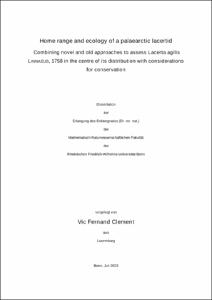Home range and ecology of a palaearctic lacertidCombining novel and old approaches to assess Lacerta agilis LINNAEUS, 1758 in the centre of its distribution with considerations for conservation

Home range and ecology of a palaearctic lacertid
Combining novel and old approaches to assess Lacerta agilis LINNAEUS, 1758 in the centre of its distribution with considerations for conservation

| dc.contributor.advisor | Rödder, Dennis | |
| dc.contributor.author | Clement, Vic Fernand | |
| dc.date.accessioned | 2024-02-28T13:53:23Z | |
| dc.date.available | 2024-02-28T13:53:23Z | |
| dc.date.issued | 28.02.2024 | |
| dc.identifier.uri | https://hdl.handle.net/20.500.11811/11362 | |
| dc.description.abstract | Effective species conservation requires a thorough understanding of a species’ ecology as it reveals the requirements a species has of its environment. In this thesis I combine established methods like visual encounter surveys and the processing of local weather data with novel methods like radio-telemetry on sand lizards and habitat mapping by UAV to make an ecological profile for a population of Lacerta agilis from the centre of its range. In several papers, me and my colleagues analyse different aspects of sand lizard ecology: The spatio-temporal patterns in microhabitat and weather preferences, the weather dependent detection probability, and the home range and habitat selection. Before that, I summarize previous studies of home range and habitat selection in vertebrates to identify the allocation of focus towards vertebrate orders and topics and to understand, where the study of Lacerta agilis fits into previous work. In summary, allocation of focus on vertebrate orders in home range and habitat studies is independent of species diversity within the order as well as relatedness between orders or portion of vulnerable species within orders. Furthermore, many marine turtles and mesocarnivores were among the most studied species and topics most studied in concordance with home range and habitat selection are conservation/human influence, intraspecific differences, and home range shifts and exploratory behaviour. In the following, the thesis focuses on establishing an ecological profile of L. agilis. First, the data shows, that the studied central population varies greatly in spatio-temporal patterns of microhabitat and weather preferences from much studied populations at the ranges edge. Overall, the spatio-temporal patterns in habitat selection of L. agilis in this population cannot be explained by season, weather or microclimate and only very minor differences between ontogenetic stages, sexes or daytime can be observed. Overall, L. agilis of this population occupy a broad niche but are most active in dry and sunny conditions with low windspeeds after air temperatures reached values around 20°C for a few hours. In terms of habitat, lizards favour incorporating blackberry bushes into their home range while avoiding large areas of sand and tall vegetation. My results show the need for local data in conservation and help improving conservation of local populations by detailing weather dependent encounter rates and fine-scale habitat selection. I furthermore supply a combination of methods many of which are designed to remain useful for a multitude of organisms and applicable in conservation and management work. | en |
| dc.language.iso | eng | |
| dc.rights | In Copyright | |
| dc.rights.uri | http://rightsstatements.org/vocab/InC/1.0/ | |
| dc.subject | Lacerta agilis | |
| dc.subject | Aktionsraum | |
| dc.subject | Raidorelemetrie | |
| dc.subject | Unbemannte Luftfahrzeuge | |
| dc.subject | Habitatkartierung | |
| dc.subject | Naturschutz | |
| dc.subject | home range | |
| dc.subject | radio telemetry | |
| dc.subject | unmanned aerial vehicles | |
| dc.subject | habitat mapping | |
| dc.subject | conservation | |
| dc.subject.ddc | 570 Biowissenschaften, Biologie | |
| dc.subject.ddc | 590 Tiere (Zoologie) | |
| dc.title | Home range and ecology of a palaearctic lacertid | |
| dc.title.alternative | Combining novel and old approaches to assess Lacerta agilis LINNAEUS, 1758 in the centre of its distribution with considerations for conservation | |
| dc.type | Dissertation oder Habilitation | |
| dc.publisher.name | Universitäts- und Landesbibliothek Bonn | |
| dc.publisher.location | Bonn | |
| dc.rights.accessRights | openAccess | |
| dc.identifier.urn | https://nbn-resolving.org/urn:nbn:de:hbz:5-74047 | |
| dc.relation.doi | https://doi.org/10.11160/bah.242 | |
| ulbbn.pubtype | Erstveröffentlichung | |
| ulbbnediss.affiliation.name | Rheinische Friedrich-Wilhelms-Universität Bonn | |
| ulbbnediss.affiliation.location | Bonn | |
| ulbbnediss.thesis.level | Dissertation | |
| ulbbnediss.dissID | 7404 | |
| ulbbnediss.date.accepted | 28.11.2023 | |
| ulbbnediss.institute | Angegliederte Institute, verbundene wissenschaftliche Einrichtungen : Zoologisches Forschungsmuseum Alexander Koenig (ZFMK) | |
| ulbbnediss.fakultaet | Mathematisch-Naturwissenschaftliche Fakultät | |
| dc.contributor.coReferee | von der Emde, Gerhard |
Files in this item
This item appears in the following Collection(s)
-
E-Dissertationen (4118)




